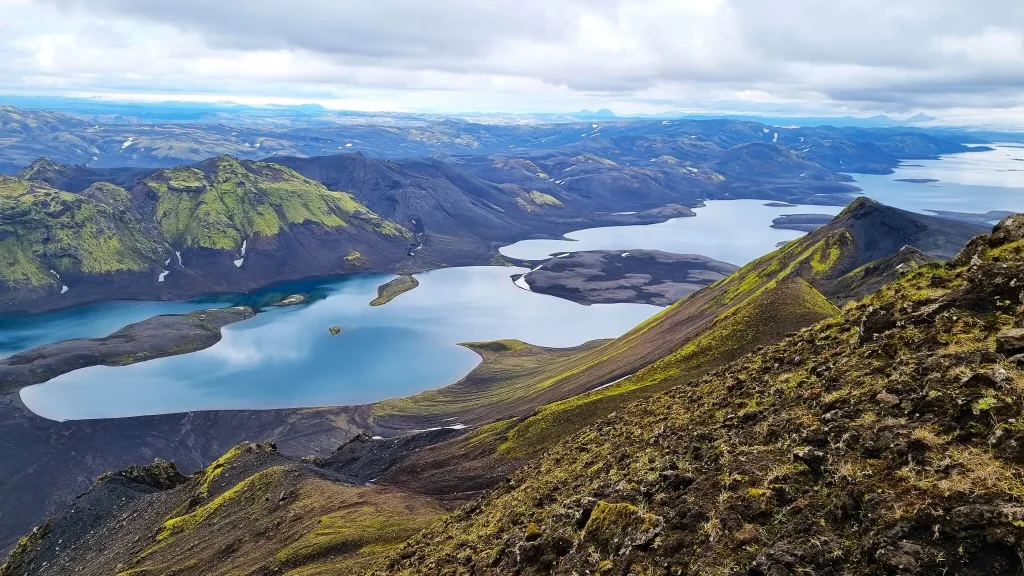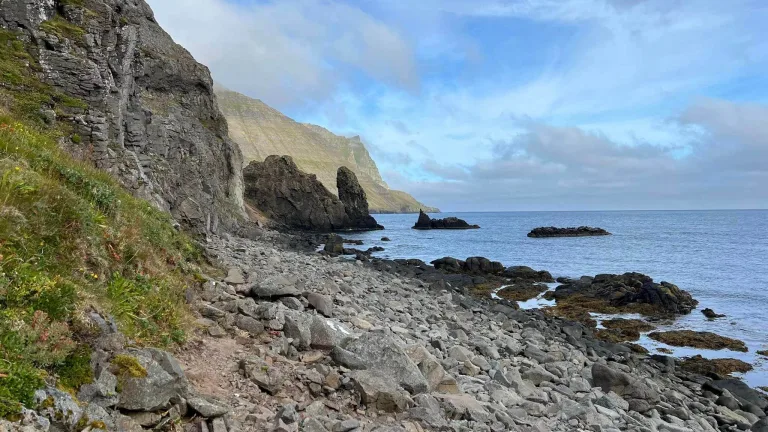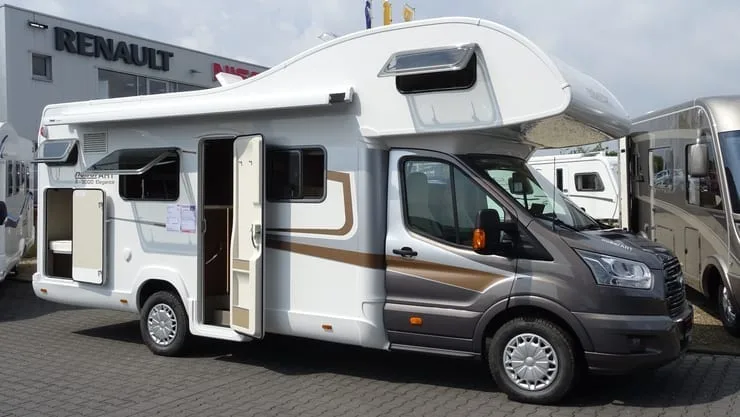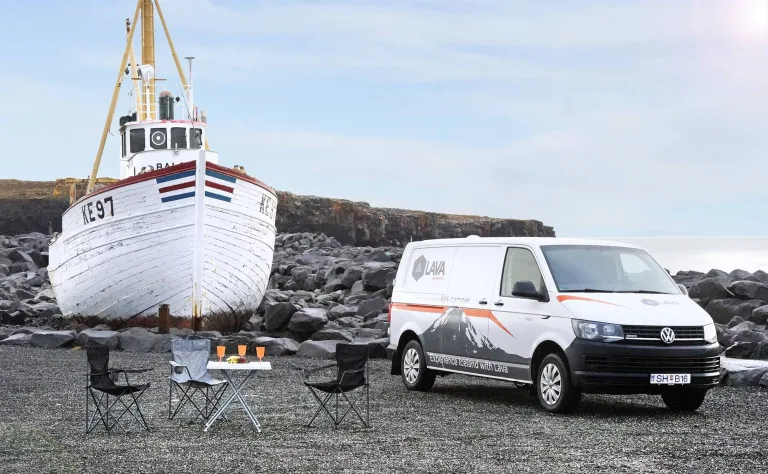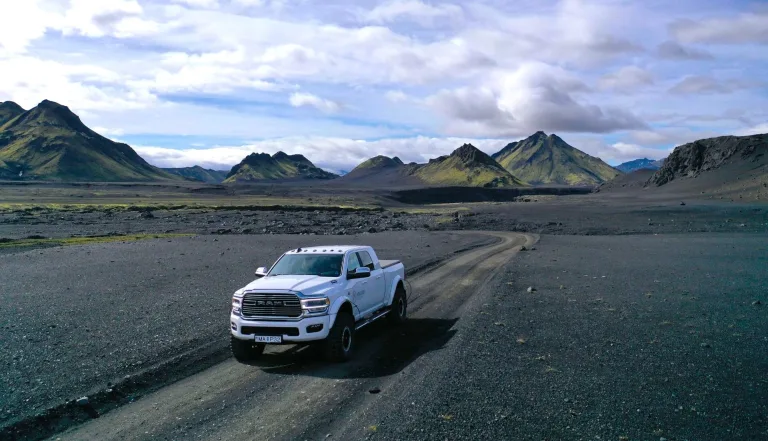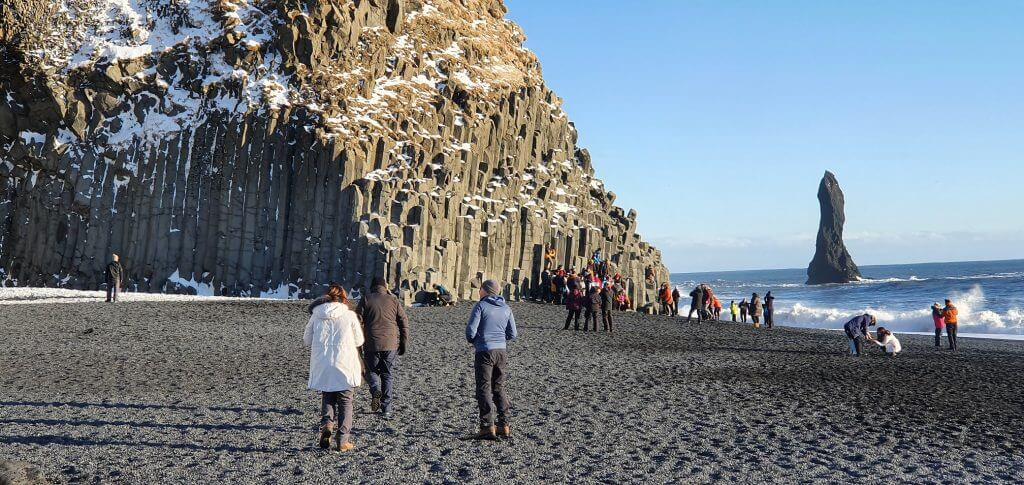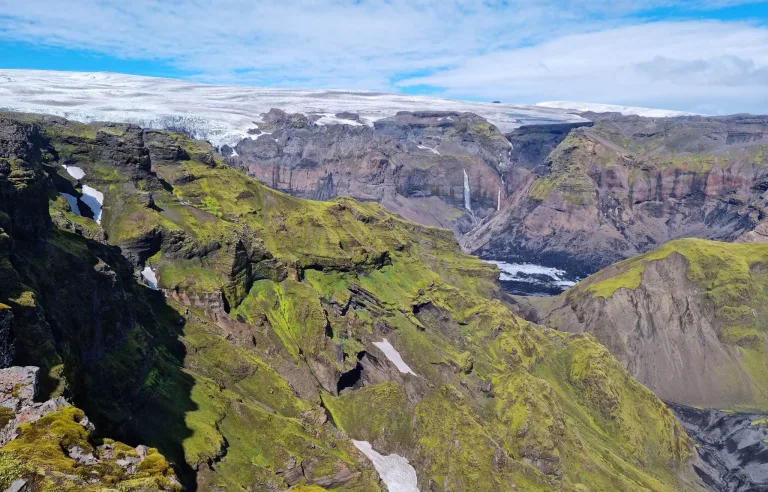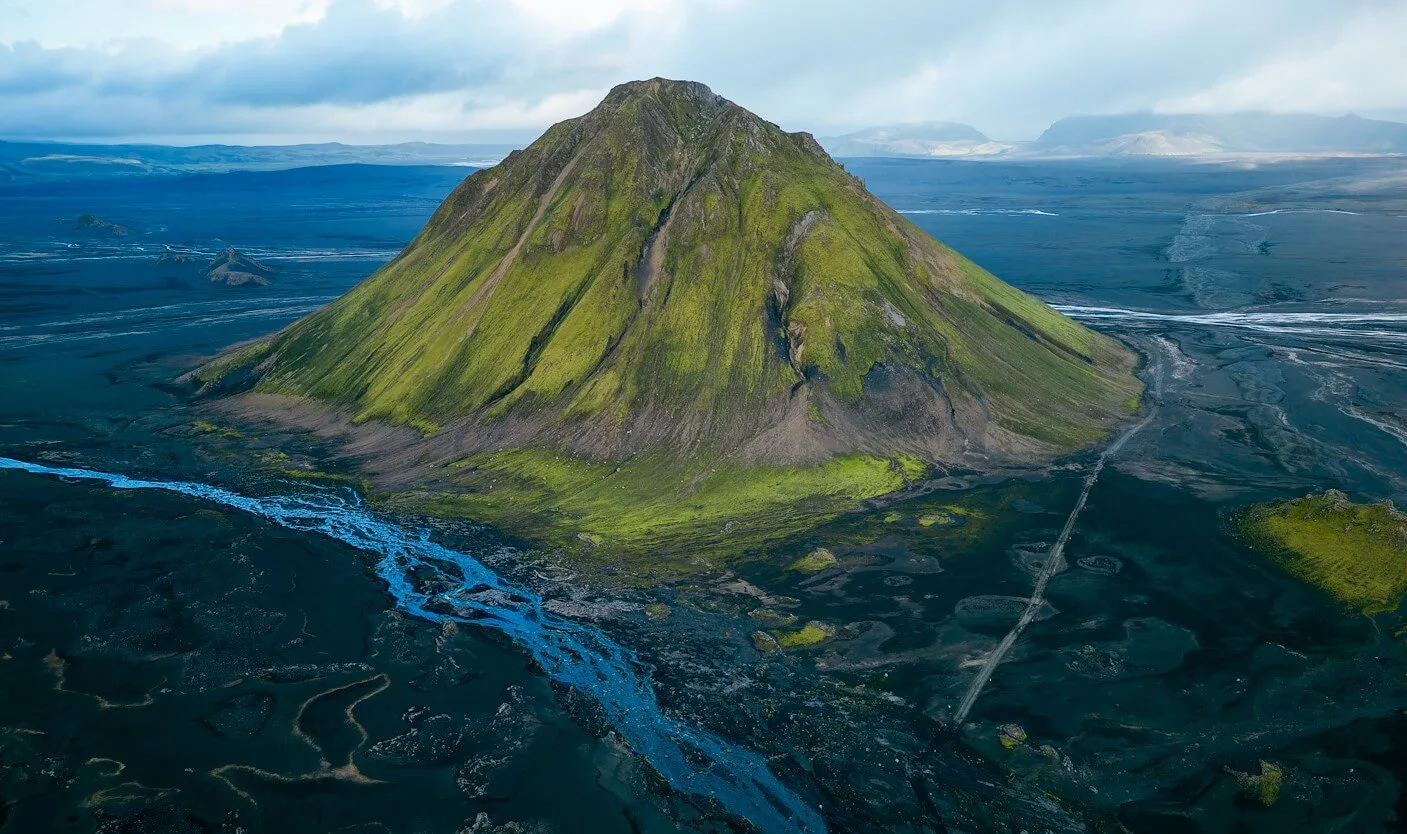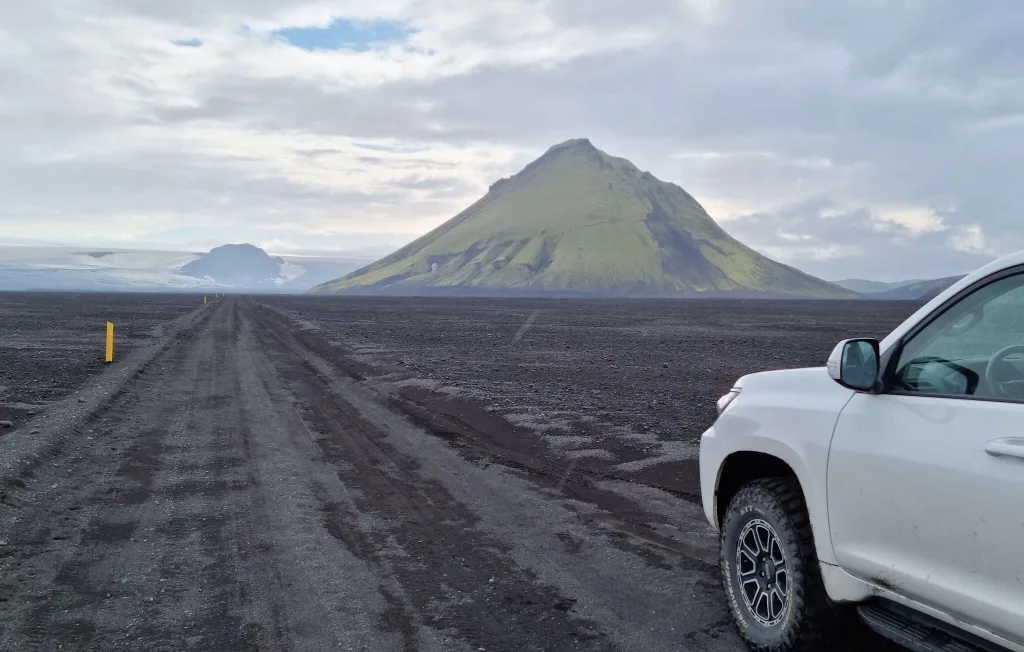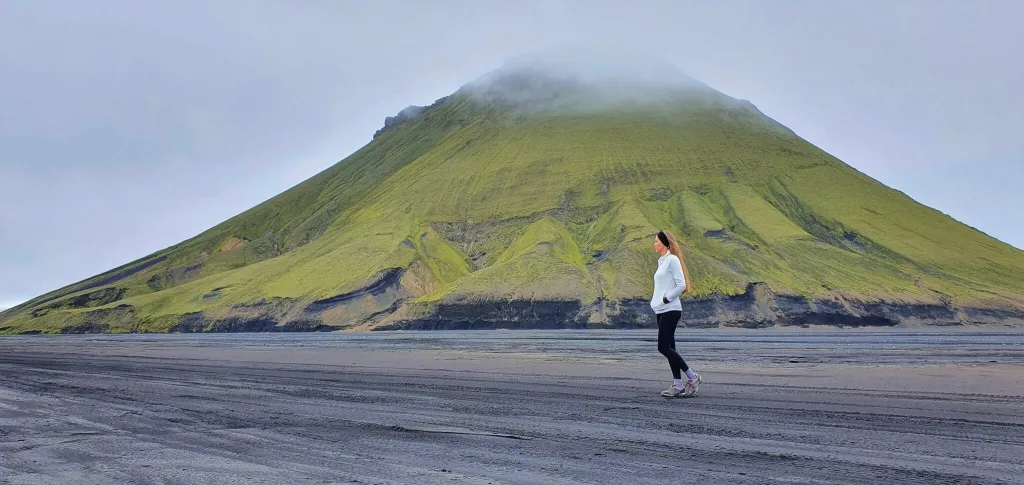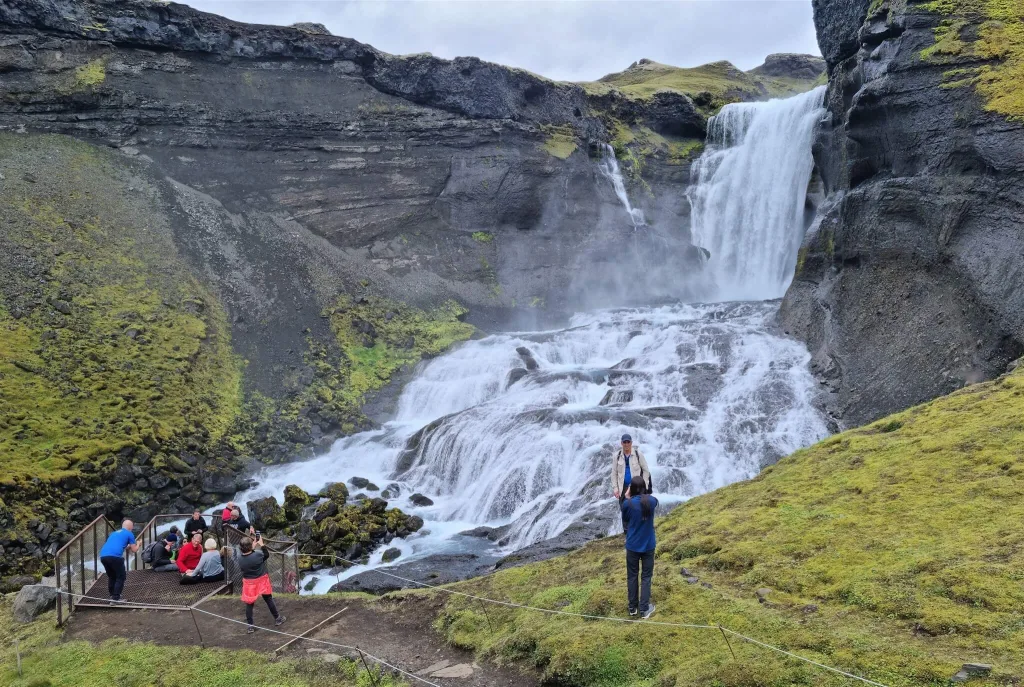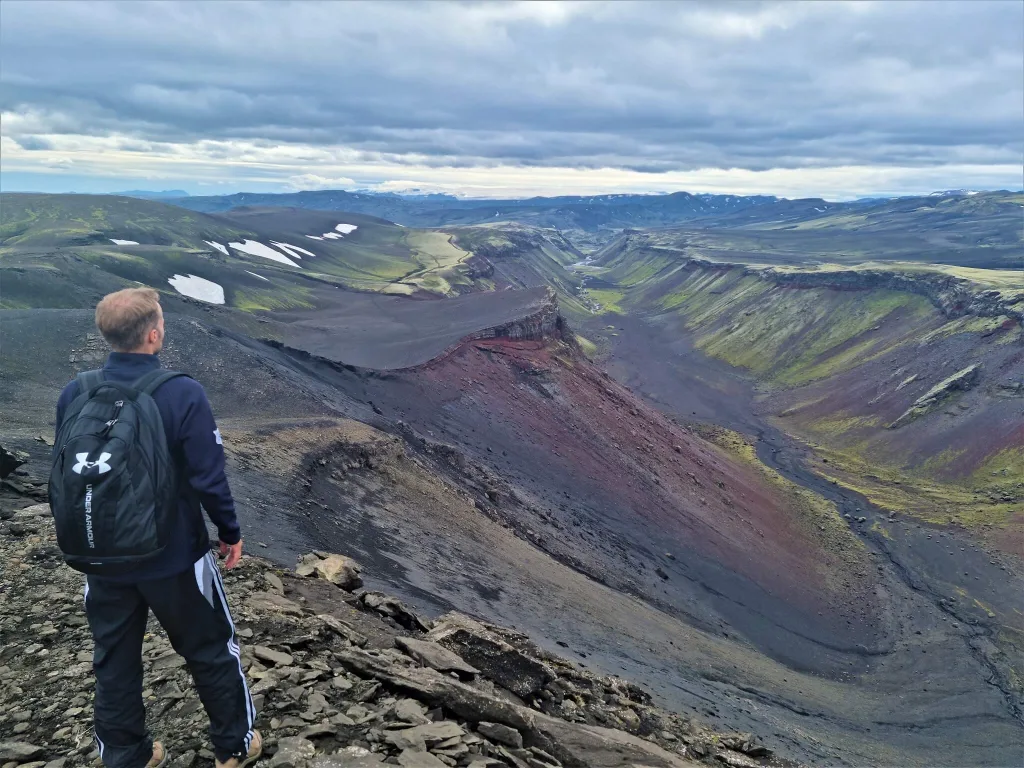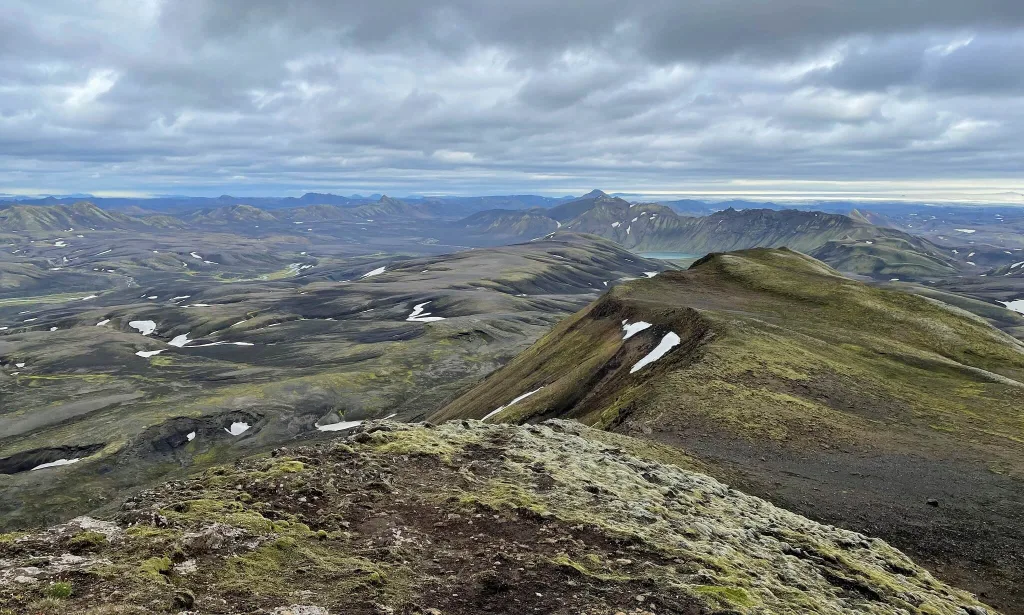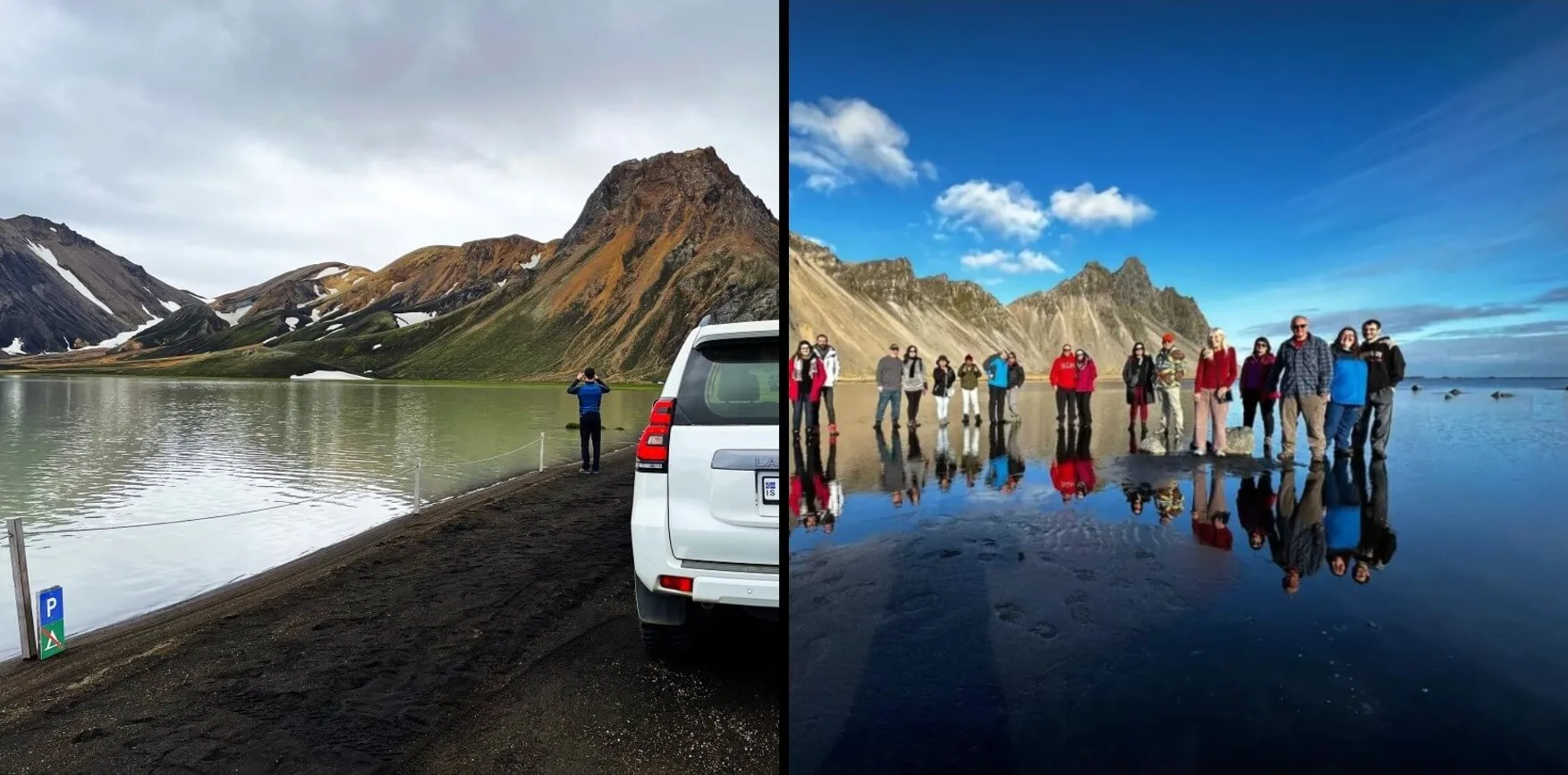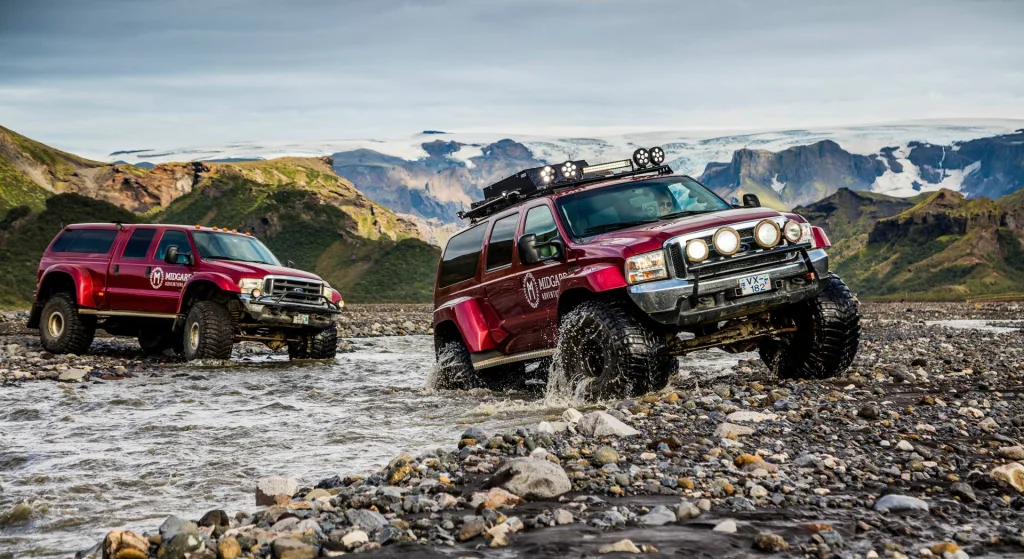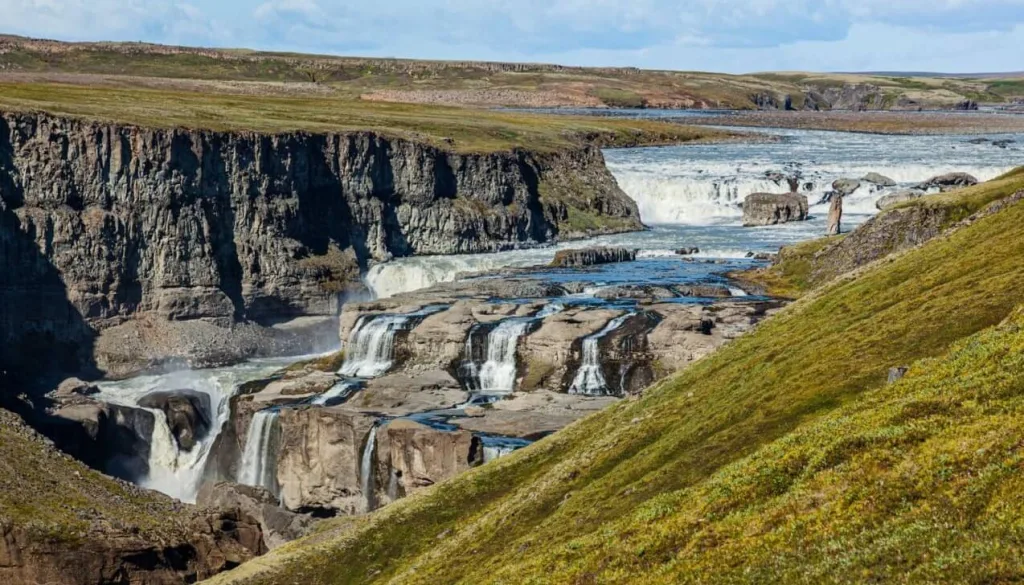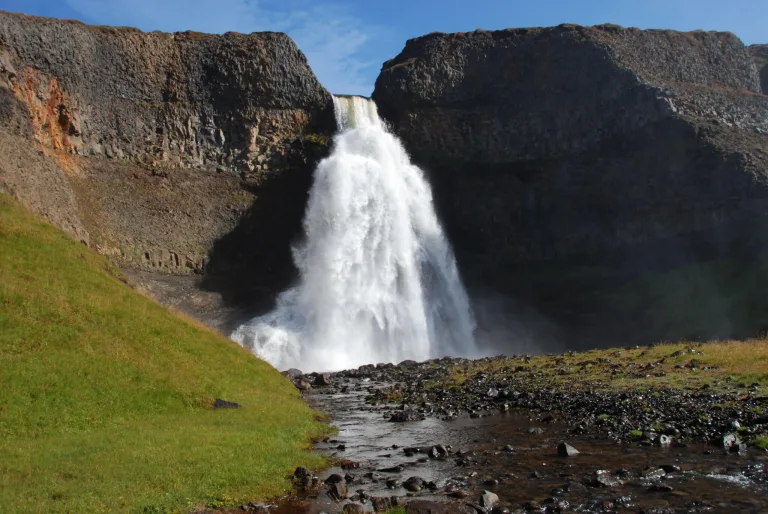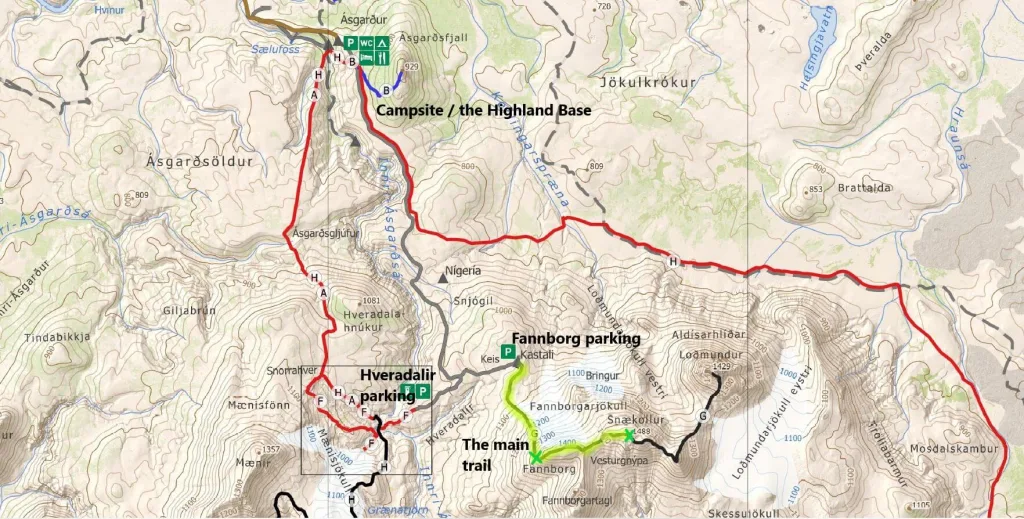We wrote this detailed guide to the Snæfellsnes peninsula, including the top things to do in Snæfellsnes, to help you plan your trip to this amazing region of Iceland. We’ve visited Snæfellsnes many times over the past years, so everything you’ll read below is our recent personal experience. Well, unlike some other blogs that just rinse and repeat the same “top places in Snæfellsnes” all over again.
Some say that the Snæfellsnes peninsula is like a miniature of Iceland. That might be true. There’s a little bit of everything – hot springs, waterfalls, mountains, wildlife, and even an F-road. Yet, Snæfellsnes is still unique and different from anything else in Iceland. That’s why it’s a perfect spot to explore for a day or two during your trip.
It was hard to narrow all the beauty down to just the 25 best spots in Snæfellsnes, but we did our best. And psst, we also added five off-the-beaten-path bonuses you typically won’t find in any other article 🙂
Contents
- Map of Best Snæfellsnes Places
- 1. Selvallavatn Area
- 2. Kirkjufell
- 3. Lóndrangar Cliffs
- 4. Ytri Tunga Seals
- 5. Lýsulaugar Hot Spring
- 6. Hraunlandarif Beach Horse Riding
- 7. Arnarstapi Village
- 8. Road 570 – Jökulshálsvegur
- 9. Búðakirkja Church
- 10. Landbrotalaug Hot Spring
- 11. Saxhóll Crater
- 12. Svöðufoss Waterfall
- 13. Rauðfeldsgjá Gorge
- 14. Djúpalónssandur Beach
- 15. Berserkjahraun Road
- 16. Vatnshellir Cave
- 17. Grundarfjörður
- 18. Killer Whales Watching
- 19. Eldborg Crater
- 20. Svörtuloft Lighthouse
- 21. Snæfellsjökull Summit
- 22. Stapafell Mountain
- 23. Grundarfoss
- 24. Stykkishólmur
- 25. Gerðuberg Cliffs
- H1. Sturlungalaug Hot Spring
- H2. Kolgrafarfjörður Bridge
- H3. Skarðsvík Beach
- H4. Helgafell Hike
- H5. Klukkufoss Waterfall
- H6. F575 F-Road
- H7. Rauðhólar Hill
- When to Visit Snæfellsnes
- How to Get to Snæfellsnes
- Best Snæfellsnes Guided Tours
- How Long to Stay in Snæfellsnes
- Snæfellsnes 1-Day Itinerary
- Snæfellsnes 2-Day Itinerary
Map of Best Snæfellsnes Places
1. Selvallavatn Area

Selvallavatn lake, hike, and waterfall in Snæfellsnes
Why Visit
Everyone writing about Snæfellsnes typically begins with the legendary Kirkjufell. Yet, no one mentions Selvallavatn. We will! Selvallavatn is a scenic natural area where most of the niche tours will take you for their first stop when touring Snæfellsnes.
Selvallavatn is a great introduction to the Snæfellsnes peninsula. First, on a clear day, you will get an amazing view over the nearby colorful hills and the Selvallavatn lake. Secondly, there’s a beautiful yet scarcely visited Sheep’s waterfall, or Selvallafoss in Icelandic.
Tips from a Local
- It’s easy to get to Selvallavatn in a 2WD car via paved Road 56 basically all year round, even for visitors with mobility issues
- You can take two short hikes from the parking area – one to the lake and the second one to the nearby hill called Horn – to enjoy even better views
2000+ Amazing Spots in Iceland in ONE MAP? Only in Our Interactive Map of Iceland!
Our Experience
We often visited Snæfellsnes in fog or when it rained, and we skipped Selvallavatn then. We didn’t want to miss the views.
On a nice sunny day, though, Selvallavatn makes for a short and beautiful stop that is definitely worth doing.
2. Kirkjufell

Happy me in front of Kirkjufell and Kirjufellsfoss
Why Visit
Kirkjufell is the most photographed spot in Iceland. During sunrise or sunset, with northern lights glowing above, under the snow cover, or with a sunny background. Almost whatever you choose, it’s gonna be picturesque and scenic. Maybe, except for Kirkjufell in the rain and fog, lol.
Apart from Krikjufell, you’ll also find a cute waterfall right next to the parking area called Kirkjufellsfoss. Taking a picture of Kirkjufell and Kirkjufellsfoss is definitely one of the top things to do in Snæfellsnes!
Tips from a Local
- Did you know you can take an easy hike right around Kirkjufell itself? And very few people actually do that!
- It used to be possible to climb all the way up to the peak of Kirkjufell. It is a very steep and dangerous hike, in some parts resembling mountain climbing. Several deaths occurred here. In recent years, locals have often closed the peak hiking trail due to that. If you are an experienced climber, always check with locals if the hike is open at the time of your visit.
Our Experience
If we want to avoid crowds in Iceland, we always visit Kirkjufell outside of regular hours, i.e., either super early or super late. There’s a paid car park with enough space. We’ve seen many people not paying for their tickets, and we don’t recommend doing that. There are cameras, and you’ll get a fine.
Rather than parking at the paid car park and fighting the crowds, we often stop further away, along the road, in one of the car parks, or even in Grundarfjörður. We prefer to enjoy Kirkjufell from a distance, with no tourists around.
3. Lóndrangar Cliffs
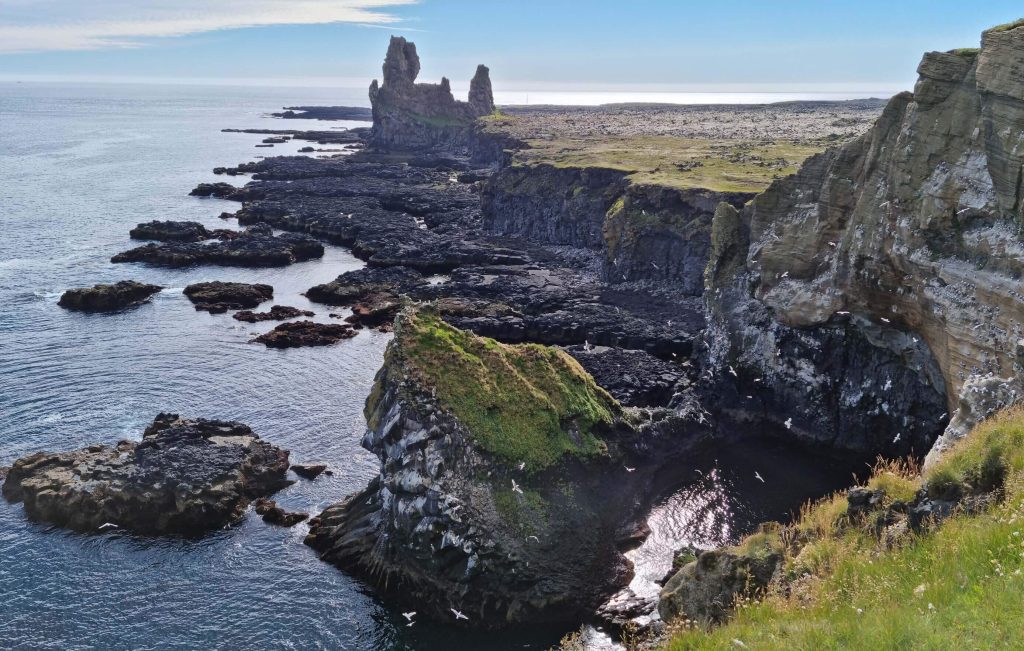
Lódrangar cliffs are one of our favorite places in Snæfellsnes!
Why Visit
In our opinion, Lóndrangar Cliffs are one of the best places on the Snæfellsnes peninsula, if not the best. Cliffs are super scenic, and guess what? Puffins are often around!
Puffins are not the only ones, though. Lóndrangar is rich in birdlife, making it a great spot for bird watchers.
Tips from a Local
- When it’s too foggy, it’s not worth visiting Lóndrangar. You will essentially see nothing. This was Lóndrangar in fog during our first visit.
- There are two main viewpoints of Lóndrangar Cliffs – the eastern one and the western one. You can get an amazing sunset photo from the eastern viewpoint. On the other hand, if you visit in the afternoon, it’s best to take the western Lóndrangar viewpoint for your pictures to avoid the sun in the background.
Our Experience
Whenever we drive through Snæfellsnes on a clear day, we always stop at Lóndrangar. This place is magical.
I could stay and watch the waves bashing at the cliffs and birds peacefully hunting for their food all day long. Such a fairy-tale-like place!
4. Ytri Tunga Seals

Watching seals at Ytri Tunga is one of the top family activities in Snæfellsnes
Why Visit
Ytri Tunga is one of the best places in Iceland to watch seals in their natural habitat. The chances to spot seals here are very high. The seals like to sunbathe on sunny days, but they also populate this area on cloudy days.
Please keep a safe distance of at least 50 meters (160 feet) from Icelandic seals to not disturb them! Don’t ruin their home!
Tips from a Local
- In case the seals are too far away, you can get a bit closer by jumping on rocks. They are very slippery, though, so be very careful!
- Take binoculars! You will get the best seal views without risking slipping on rocks.
Coming in Winter? Be sure to check our Top Winter Places in Snæfellsnes!
Our Experience
We love to take children to this place and play a game of who spots more seals 🙂 There’s a parking place with enough space right next to the viewing area. It’s again best to come on a clear day and give kids the binoculars so that both the seals and your kids are safe.
5. Lýsulaugar Hot Spring
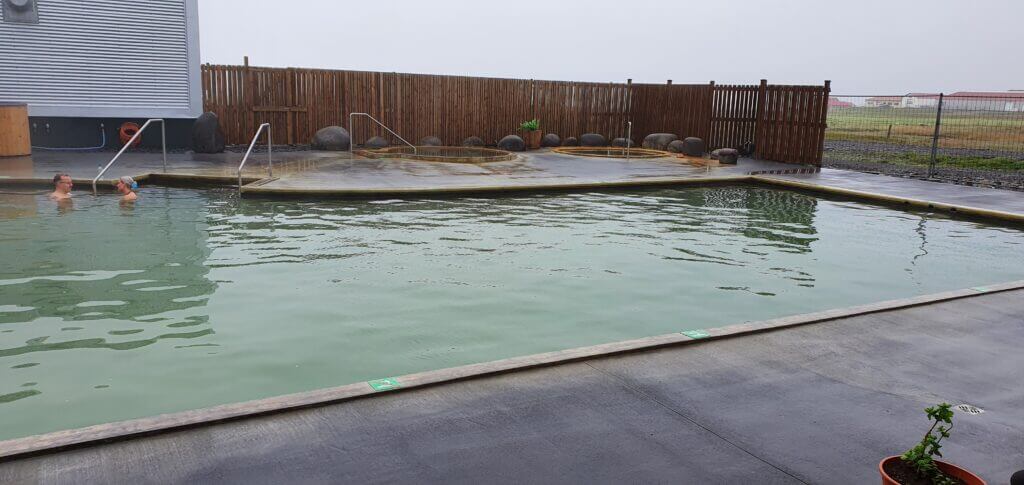
Lýsuhólslaug hot spring
Why Visit
Lýsulaugar, formerly Lýsuholslaug, is the only paid and man-maintained hot spring lagoon in Snæfellsnes. It’s an amazing place to pause and relax during your road trip.
Tips from a Local
- There are four hot pools in total: a) the main pool with lukewarm water and algae, b) two hot jacuzzis of various temperatures, and c) a barrel with cold water
- Don’t be scared of algae. This one is perfectly safe for everyone and actually has health benefits! Just be careful about slipping in the main pool. The algae cover the ground as well.
Our Experience
Bathing in Lýsuholslaug is definitely a very pleasant activity when the weather sucks. We really enjoyed it, despite the place not being anywhere near as picturesque as Hrunalaug or some other “wilder” hot springs. So, it depends on your preference, the weather (and who knows what else) if it’s worth making a detour for you. For us, it definitely is.
6. Hraunlandarif Beach Horse Riding

Horse riding on a beach is one of the top things to do in Snæfellsnes!
Why Visit
Hraunlandarif Beach Horse Riding was our top activity in Snæfellsnes. The beach is picturesque, and riding on it on a horse feels like starring in a movie! No matter what your horse-riding skills are.
Tips from a Local
- The minimum age for beach horse riding is 7 years. If your kid is younger, a guide can take him on a horse near the stable instead.
- It’s OK to take this tour in light rain, though we don’t recommend going in heavy rain. It’s possible, just not very pleasant. That being said, if you can make it, even in the rain, it can be a once-in-a-lifetime experience!
Our Experience
The small local family company doing horse riding tours on the Hraunlandarif Beach is called Stóri Kambur. We took their 1-hour tour, and it was lovely!
The guides will not only take you to the beach, but they will also make you cross the lake on a horse! Something we definitely weren’t mentally prepared to do when taking the tour for the first time, lol! But everything went alright and we just ended up with some unforgettable memories!
7. Arnarstapi Village

Arnarstapi cliffs in winter
Why Visit
Arnarstapi is one of the smallest seaside villages in Snæfellsnes, offering some mesmerizing shore and cliff views.
There’s a well-maintained walking path along the entire picturesque shore. That’s where you can admire the power of the waves, the stunning Gattklettur rock, and the Arnarstapi lighthouse.
Tips from a Local
- You’ll find two restaurants, a gas station, a campsite, and several cozy Bed & Breakfasts in Arnarstapi, some with really unique views
- Arnarstapi, contrary to many other spots, can also be visited when the weather is a bit harsher. The village is all paved and accessible also to visitors with mobility issues.
Be sure to save money thanks to our Icelandic discount codes on tours and car rentals!
Our Experience
We have visited Arnastapi both in summer and in winter and love its tiny vibe. You don’t have to spend too much time in here, we typically stay for an hour or so.
The walk along the shore takes about 15 minutes one way and is very easy. Just be careful in winter, as it might be icy and slippery, as basically anywhere else in Iceland.
8. Road 570 – Jökulshálsvegur

Road 570 Snæfellsness near Snæfellsjökull
Why Visit
Road 570, or Jökulshálsvegur in Icelandic, is a scenic mountain road. It will take you to the highest drivable point on the entire peninsula, right beneath the tallest peak of Snæfellsnes – Snæfellsjökull.
Tips from a Local
- The road is passable for normal passenger cars only in summer, typically from July until September
- The view from the highest point of the road towards the south shore of Snæfellsnes is one of a kind!
Our Experience
For me, as a huge road enthusiast, driving on the 570 is one of the top things to do in Snæfellsnes. We actually had a very unique experience when we drove through Jökulshálsvegur for the first time.
We had planned to drive Jökulshálsvegur for the first time on the 20th of July 2022, which was a year of an extraordinarily strong winter. Everything had already been booked, so we had no choice but to go. On the day of our visit, however, Road 570 was still marked as impassable on www.umferdin.is. We wondered why.
At that time, we had a super jeep rented and were planning to go to the highlands afterward. So, we decided to give it a try and take a look at the road. Worst case, we could turn around.

Road 570 in a tiny piece of highland in Snæfellsnes at the end of July 2022
After about 10 minutes of uphill driving, we soon realized what the problem with the road was. Snow. There were still large snow patches left after winter, located on a steep uphill. We were very hesitant to continue and wanted to turn around as planned in such a case.
At that very same moment, though, we met a local in his jeep driving the other way around. We asked him about the road conditions, and he gave a quick glance at our car and said: “With your car, you can pass it”. So be it, we said to ourselves, and full of excitement, we went onwards.
Luckily, our jeep was able to pass all the snow patches, and this ride has become deeply rooted in our memories as one of the most exciting rides of our lives! After a few steep patches of snow, we even had to drive through multiple uphill snow tunnels! Don’t try this in the Dacia Duster! 🙂
Right after we finished driving the 570, we looked again at www.umferdin.is, and we saw the road marked in green: “mountain vehicles only”. Only then did we finally realize what had happened. Apparently, a snowplow had driven the road just a few hours, maybe minutes, before us, creating all those snow tunnels and making the road passable. Well, these are the things that can happen to you in Iceland! 🙂
9. Búðakirkja Church
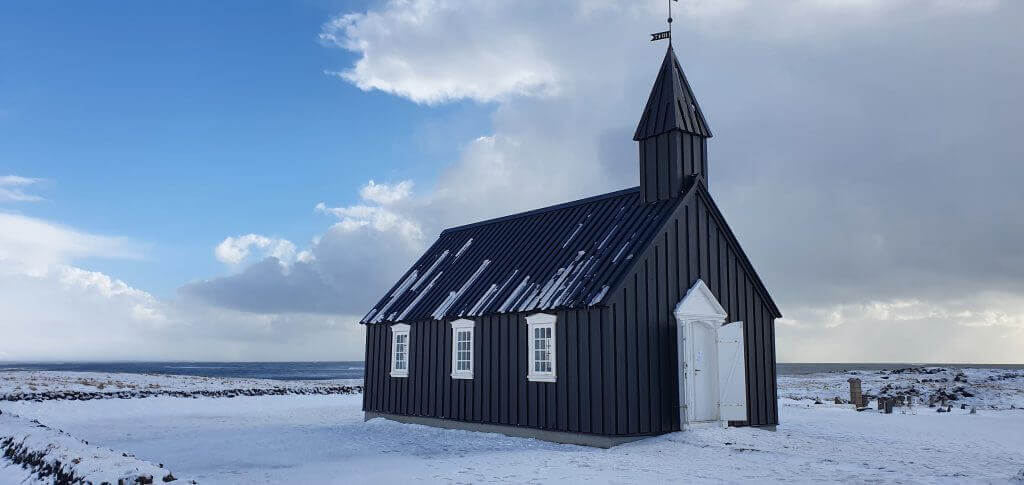
Búðakirkja in winter
Why Visit
Búðakirkja is an iconic black church. It’s a stunning place for photographers, basically in any kind of weather! Búðakirkja has a firm place among our favorite things to do in Snæfellsnes.
Tips from a Local
- Búðakirkja is generally locked and unavailable for tourists. It only opens for local celebrations, weddings, or special ceremonies.
- The church is located just a 5-minute drive from the main road 54, or Snæfellsnesvegur in Icelandic. You can easily visit it all year round.
Our Experience
Búðakirkja is our popular stop whenever we visit Snæfellsnes. There are rarely many visitors around. Moreover, the place has a unique vibe that’s hard to describe, and you just have to experience it yourself!
The church belongs to one of those places you don’t want to be missing from your Iceland photo album. We visited Búðakirkja in all seasons and can confirm it’s super picturesque both in summer and in winter.
10. Landbrotalaug Hot Spring

Wild and rough Landbrotalaug hot spring
Why Visit
Landbrotalaug is a wild hot spring located in the eastern part of Snæfellsnes. Bathing in Landbrotalaug is a once-in-a-lifetime outdoor experience, especially for adventure seekers!
This is a place for those who don’t mind the lack of any facilities such as a changing room, toilet, or any spot to leave your clothes 🙂 This all is part of the Lanbdrotalaug experience!
Tips from a Local
- Landbrotalaug consists of two pools – a smaller, natural pool that fits 2 to 3 people at max and a larger man-made pool with more cloudy water
- Water in the hot springs varies anywhere between 34°C (93°F) to 40°C (104°F) with no predictable patterns. As wild as it gets!
Do you know how to choose the best car for Iceland?
Our Experience
To reach Landbrotalaug, we took a turn to Stóra-Hraun, a dirt road, working as a detour from the main Road 54 (Snæfellsnesvegur). There’s a gravel parking place that can accommodate up to ten cars. Let’s hope you won’t see that many when there 🙂
It took us just a few minutes to reach the hot spring from the car park. Just bear in mind that there’s no sidewalk or anything similar. If you are going in the rain, there may be water and mud all around. Be ready for it, or don’t go.
We were lucky enough to be alone at Landbrotalaug and loved it! That is, however, often not the case. The pool is getting increasingly popular, so we suggest visiting during non-peak times.
11. Saxhóll Crater

Saxhóll crater in the distance
Why Visit
Saxhóll Crater is a unique red volcanic crater overgrown with moss. Saxhóll is a quick and easy stop on the westernmost part of the Snæfellsnes peninsula.
Tips from a Local
- Thanks to the attached staircase, you can actually climb the crater all the way to the top to see its base.
- Saxhóll crater is most stunning in summer or whenever there’s no snow. This is when the craters’ colors are the most vibrant.
Our Experience
We visited Saxhóll Crater on our first trip to Snæfellsnes as a quick stop on our journey. We parked our car right at the bottom of the crater in the car park. It took us about 2 minutes to get up the staircase.
Crater is one of the must-see places in Snæfellsnes, though maybe it’s enough to see it just once. For us, it has been. It’s a nice place, though not on our list of “to-return” places.
12. Svöðufoss Waterfall

Svöðufoss waterfall. Photo by Veronique Lopez, CCM license.
Why Visit
If you love waterfalls and easy hikes, then you’ll love Svöðufoss! It’s one of the most beautiful waterfalls in northern Snæfellsnes, near the village of Ólafsvík.
Tips from a Local
- Svöðufoss is not the only waterfall in the area. There’s also Kerlingarfoss right next to it! When you are in the area, we recommend you go see both!
- There’s a paved sidewalk leading from the small parking place right below the waterfall. You can visit it in any season. In winter, we recommend wearing spikes, though.
Our Experience
Svöðufoss is scenic and definitely belongs to the less visited places in Snæfellsnes, which is why we like it 🙂 You must drive a short stretch of an easy gravel road to reach the parking spot. It can be easily done even in a 2WD car. In winter, a 4WD car may help you avoid getting stuck in the snow.
It took us about 7 minutes of walking to reach Svöðufoss from the car park. You can even climb above the waterfall and back. This will add about 30 minutes as a round-trip to your hike.
13. Rauðfeldsgjá Gorge
Why Visit
Rauðfeldsgjá Gorge is a beautiful canyon in southern Snæfellsnes that you can actually hike into. It’s a stunning place for anyone who enjoys ravines, not that much for others, though.
If you decide to hike into the gorge, get ready for slippery stones and potentially wet shoes 🙂
Tips from a Local
- The deeper you get into the gorge, the harder it gets to pass. Some parts even require a bit of climbing. This hike is only for the fit ones. You can always turn back at any time, though.
- Rauðfeldsgjá Gorge is a very popular tourist spot. If you want to avoid such places, then Rauðfeldsgjá is not a place for you.
- The gorge is accessible in summer only, or at least outside of the snow season. In winter, it gets filled with snow and ice, making it dangerous to visit.
Our favorite part of Iceland? Check out 25 Best Places in the Highlands of Iceland!
Our Experience
The last time we visited Rauðfeldsgjá in July, a lot of people were trying to cram in and out of the place alongside us. At some points, there were even queues out there. This is the part we like the least about the gorge.
The deeper we got into the gorge, the more people we met giving up to proceed. And for a reason. We had to do some climbing on slippery stones to be able to get further into the ravine.
At one point, we reached the spot where we could only see a little waterfall in front of us and no other path. I guess this is the furthest you can go, but I may be wrong 🙂 We turned back. Nevertheless, Rauðfeldsgjá is nice but has not enchanted us that much compared to many other amazing places in Iceland.
14. Djúpalónssandur Beach

Djúpalónssandur beach is supposed to be one of the best places in Snæfellsnes. Not for us, though.
Why Visit
Djúpalónssandur is one of the most beautiful black sand beaches in Snæfellsnes. It’s a very popular place among tourists, with several visitor paths available.
Tips from a Local
- At one point, Djúpalónssandur was even closed to visitors due to over-tourism and nature protection. Since then, barriers and walking paths have been built.
- Dangerous “sneaky waves” may occur at the beach, similar to the Reynisfjara black sand beach. Don’t get too close to the water!
Our Experience
While Djúpalónssandur is often cited among the best places to visit in Snæfellsnes, it’s not among our top favorites. The main reason is that many people visit the beach, and you can find many other remote places in Iceland, including beaches, that are similarly beautiful and much less populated.
That being said, it’s very easy to see the beach, and you can just make a quick stop and form your own opinion 🙂
15. Berserkjahraun Road

Scenic Road 558 -Berserkjahraun – leading through the lava field
Why Visit
Berserkjahraunsvegur, or Road 558, is one of the most epic roads you can drive in Snæfellsnes. It leads THROUGH the lava field and can be very scenic on a nice sunny day.
Beware, though, Berserkjahraun is a tertiary road, not your regular Icelandic road. You won’t find it on all the maps. But it’s a simple drive you can effortlessly make even in a 2WD car in the summer.
Tips from a Local
- The road is typically open and passable only in summer, between June and October.
- There are many beautiful photo spots along the track. When stopping your car, leave enough space for other cars to pass, and never step on the moss!
Our Experience
We enjoyed Berserkjahraun on a beautiful sunny day in July and will definitely come back also next time. The road is short and offers some really nice views around the area.
Road 558 passes, among others, two beautiful small fjords – Hraunsfjörður and Seljafjörður.
16. Vatnshellir Cave
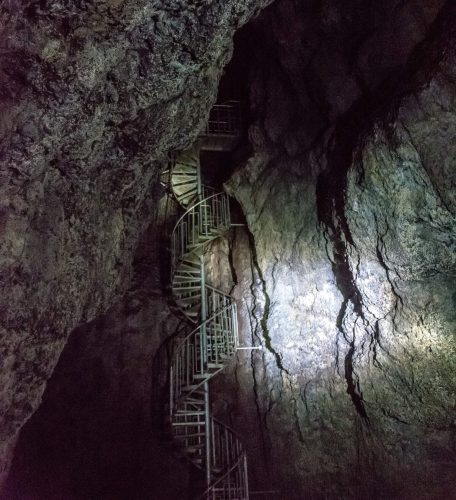
Vatnshellir Cave. Picture by Domenico Convertini under CC2.0 license.
Why Visit
Vatnshellir Cave is the most popular dry cave in Snæfellsnes, and it is accessible at any time of the year. You have to take the tour to see it in full.
Tips from a Local
- Wear sturdy shoes and dress accordingly. The temperature in the cave is cool year-round—usually around 0–4°C (32–39°F).
- The tour can sell out. We recommend booking in advance and rescheduling your tour free of charge up to 4 hours before departure.
Staying in Reykjavik? Our 21 Favorite Day Trips from Reykjavik might help!
Our Experience
If you are a fan of caves, Vatnshellir is one of the must-sees in Snæfellsnes for you. We are more into ice caves, so Vatnshellir is not really our thing, but that doesn’t have to be the same for others.
Vatnshellir descends roughly 35 meters underground via a spiral staircase, so it’s crucial to follow guidelines to avoid any accidents.
17. Grundarfjörður

The lovely town of Grundarfjörður with Kirkjufell in the back.
Why Visit
Grundarfjörður is a charming town right next to the legendary Kirjufell mountain. You’ll get one-of-a-kind views of Kirkjufell from many places around Grundarfjörður. Besides that, the town has a lovely vibe and some great eateries and cafes.
Tips from a Local
- Don’t miss the sunset behind Kirkjufell as observed from Grundarfjörður!
- Want to enjoy Kirkjufell for even longer? Book one of the accommodations with a Kirkjufell view!
Our Experience
There’s all you need in Grundarfjörður as a traveler – a campground, a supermarket, a gas station, and many different lodging options.
We always stop in Grundarfjörður when in Snæfellsnes. Well, partially because there’s pretty much no other option nearby, but not only due to that :))
We love the atmosphere of the town and can highly recommend the Bjargarsteinn Mathús restaurant with scenic Kirkjufell views, too. Make a reservation; the place is basically always fully booked!
18. Killer Whales Watching

Orcas whale watching tour. Picture by anim1102 under CC2.0 license.
Why Visit
Iceland is a paradise for whale-watching enthusiasts. And Orcas, or Killer Whales, are arguably the most famous visitors to Snæfellsnes! They’re especially common around the winter and early spring months, drawn by migrating herring.
Tips from a Local
- Take the whale-watching tour from Hólmavík. Locals operate it, and it’s lovely!
- Apart from Orcas, sperm whales are frequently encountered off Snæfellsnes in deeper waters, particularly in spring and summer.
Our Experience
We have yet to see Orcas and sperm whales in Snæfellsnes, but we’ve only heard great things about them! Seeing Orcas play in the ocean is a once-in-a-lifetime experience and a must-do in Snæfellsnes!
19. Eldborg Crater

Eldborg crater in Snæfellsnes
Why Visit
Eldborg Crater is a nice introduction to the Snæfellsnes peninsula and a great hike for all volcano lovers. The crater boasts various beautiful lava formations of different colors.
Tips from a Local
- Don’t mistake Eldborg in Snæfellsnes with Eldborg in Reykjanes. These are two different craters 🙂 There are actually more “Eldborgs” around Iceland due to ancient naming conventions.
- The hiking trail can be muddy or slippery, depending on weather conditions. Wear hiking boots and dress in layers to adapt to potential weather changes.
What about the List of All Hot Springs in Iceland?
Our Experience
The Eldborg Crater hike is easy as such, with an approximately 4km (2.5 mi) long hiking trail. It will take you approximately two hours to complete as a round trip.
The last part of the hike has a chain, so we don’t recommend it for those with reduced mobility.
20. Svörtuloft Lighthouse
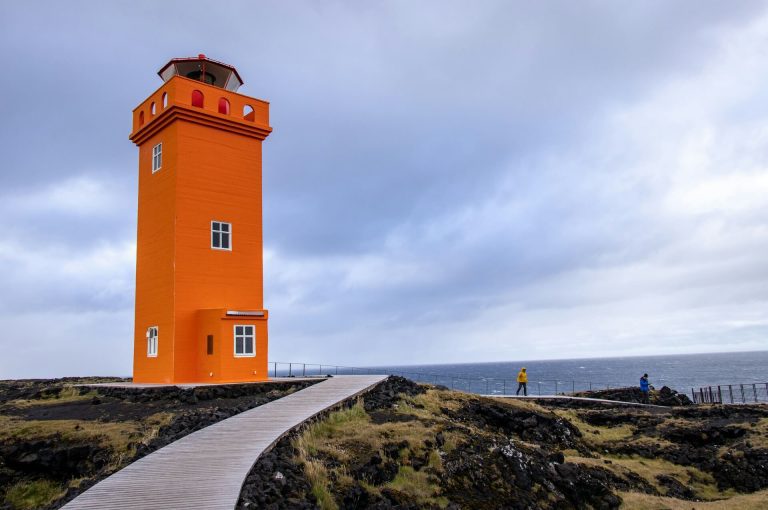
Svörtuloft lighthouse
Why Visit
Admiring stylish Icelandic lighthouses is one of our favorite things to do in Snæfellsnes. You can find eight lighthouses on the peninsula, and Svörtuloft lighthouse is arguably the most beautiful of them all!
Tips from a Local
- You can access Svörtuloft by car. No hike is needed. There’s a paved sidewalk around the lighthouse.
- The access road 579, or Öndverðarnesvegur, can get quite rough in winter. Be ready to turn around soon enough not to get stuck.
Our Experience
Svörtuloft is one of these places where we were alone basically every time we got there. And the lighthouse is not the only thing to come for!
One-of-a-kind views of the nearby cliffs and seashore will reveal in front of you from several viewing platforms around the lighthouse. The place is beautiful. Just don’t come in bad weather. The wind can get really nasty in here!
21. Snæfellsjökull Summit

Snæfellsjökull peak
Why Visit
Snæfellsjökull is the highest point in Snæfellsnes. Seeing the peak is only for the fit ones and the most adventurous ones. You have to take a guided glacier hike to reach the peak.
Once you do, you’ll be rewarded with unbelievable views of the entire Snæfellsnes peninsula!
Tips from a Local
- This is a dangerous hike you should never do alone. There are many crevasses where you can fall and die. It’s absolutely necessary you know exactly where you’re going.
- You can take a guided group tour to Snæfellsjökull from Arnarstapi, or we can arrange a private guide for you
Our Experience
We don’t recommend the hike to anyone with mobility problems, nor children below the age of 16. The roundtrip takes about 7 hours. You inevitably have to wear layers and proper clothes. A guide will provide glacier gear for you.
The hike is mostly done on snow-covered glaciers and is a once-in-a-lifetime experience! No prior glacier hiking experience is required. Just basic hiking skills.
22. Stapafell Mountain

Arnarstapi in winter with Stapafell in the background
Why Visit
Stapafell is one of the most picturesque mountains in Snæfellsnes. You can see it from the town of Arnarstapi or when driving on roads 570 or 574 nearby.
Tips from a Local
- Stapafell is actually an old volcano.
- You can’t climb Stapafell. There’s no hiking trail leading to it.
Guided Tours or Rent a Car in Iceland? Check out our decision guide!
Our Experience
Stapafell is a great spot for photographers! One of the best photo angles you can get is from the village of Arnarstapi. There, you can take a shot from around Músagjá, with a little lake in front of you, or basically from anywhere around the Arnarstapi shore.
23. Grundarfoss

Grundarfoss waterfall in Snæfellsnes
Why Visit
Grundarfoss is one of the most beautiful waterfalls in Snæfellsnes. It’s a nice family hike just next to the town of Grundarfjörður.
Tips from a Local
- The hiking trail to Grundarfoss starts at the edge of Road 54, and there’s a free parking area next to it.
- You can also climb to the top of the waterfall from the right side.
- Horses from nearby farms will often be your company. Please, don’t feed them, just observe them.
Our Experience
We could partially see Grundarfoss from the car park already. It then took us roughly 15 minutes to reach the bottom of the waterfall.
The views from the hike and from the top of the waterfall are beautiful, especially on a clear day.
24. Stykkishólmur

Stykkishólmur harbor in winter
Why Visit
Stykkishólmur is the biggest yet still cute town in Snæfellsnes. There’s all you may possibly need – a campsite, restaurants, a gas station, lodgings, a lighthouse, and even a small airport.
Tips from a Local
- A tiny harbor in Stykkishólmur is quite picturesque.
- Try “Sjávarpakkhúsið” restaurant, it’s worth it!
Our Experience
We always make a quick stop in Stykkishólmur when we are in the area. We like the peaceful vibe of the town. Oh, and don’t miss the modern church there!
25. Gerðuberg Cliffs

Gerðuberg cliffs
Why Visit
Gerðuberg Cliffs are one of the signature spots to see in Snæfellsnes. The interestingly shaped basalt columns resemble the Hallgrímskirkja church in Reykjavik and also Reynisfjara black sand beach.
Tips from a Local
- A tiny church – Rauðamelskirkja – just around the corner is free to see
- A gravel road off the main road 54 leads to Gerðuberg, but it’s typically accessible all year round, often even in a 2WD car
Tired of tourists and mainstream places? Explore 25 Hidden Gems in Iceland !
Our Experience
Gerðuberg Cliffs is the place you will find in most of the guidebooks and where all the ordinary tours will take you. Do we like it that much? Not really. It’s nice, don’t get me wrong, but it was not a highlight of Snæfellsnes for me.
If you are around and have a bit of spare time, then surely go see it. Just don’t expect too much.
H1. Sturlungalaug Hot Spring
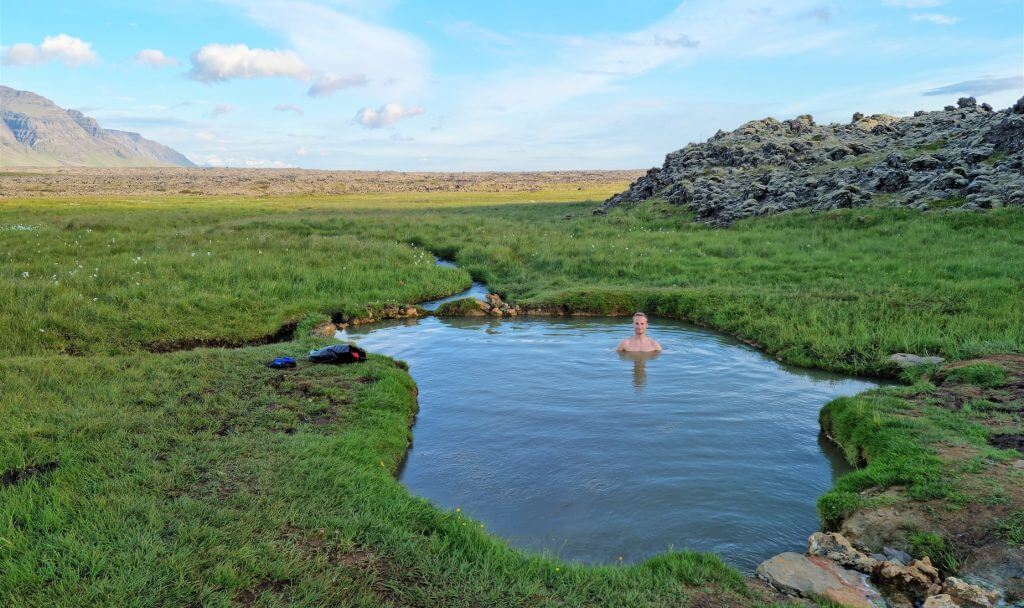
Sturlungalaug hot spring, sometimes called Guðmundarlaug, is one of the hidden gems in Snæfellsnes!
Why Visit
Sturlungalaug is an off-the-beaten-path hot spring away from civilisation and also from any comfort 🙂 It’s basically a hot hole in the grass in the middle of nowhere.
Tips from a Local
- You have to do a bit of research to find a bumpy gravel road leading to Sturlungalaug. Moreover, the road is typically passable only in summer, when it’s not covered by snow.
- No changing room. No place to leave your clothes at. No guarantee of a hot spring temperature. Wet grass all around? Possible.
Our Experience
Sturlungalaug is actually a type of hot spring we adore. Yes, it may be uncomfortable to visit, but its wild vibe is what makes it unique!
We’ve been here alone and will come back one day!
H2. Kolgrafarfjörður Bridge

Kolgrafarfjörður Bridge is one of the top things to see in Snæfellsnes. Picture by Ævar Guðmundsson under CC2.0.
Why Visit
Have you ever seen a drone photo of a stunningly scenic Icelandic road that looked almost artificial? Well, that might have been Kolgrafarfjörður Bridge! It’s located in Kolgrafarfjörður in Snæfellsnes, between the towns of Grundarfjörður and Stykkishólmur.
Kolgrafarfjörður Bridge is one of the best drone photo spots on the Snæfellsnes peninsula. Whether in summer or in winter, it’s one of the most picturesque roads in Iceland!
Tips from a Local
- Do not park on the bridge. There’s no designated parking space. Find a place somewhere nearby and walk the final meters.
- If you don’t have a drone, don’t be sad! You can take a look at the beautiful fjord from the ground as well. The best ground viewpoint is located on Road 54, just west of the bridge.
Our Experience
We love Kolgrafarfjörður because it’s very little known and far from all the tourist crowds. In spite of the bridge having quite frequent traffic, almost nobody stops to enjoy the views over the fjord!
H3. Skarðsvík Beach

Skarðsvík beach is one of the hidden gems in Snæfellsnes
Why Visit
Everybody talks about Djúpalónssandur beach, but no guidebook mentions Skarðsvík beach! Skarðsvík is actually much more remote and, in our opinion, even more beautiful than Djúpalónssandur!
Seeing Skarðsvík beach is surely one of the best things to do in Snæfellsnes!
Tips from a Local
- You can visit both Skarðsvík beach and Svörtuloft lighthouse in one go. They are located close to each other, so definitely go and see both!
- Don’t go too close to the waves. It might be dangerous.
Here are our 15 Favorite Guided Tours in Iceland.
Our Experience
Skarðsvík is a cute, off-the-beaten-path beach where you can peacefully stroll for as long as you wish. Just dress well. Shore areas might be very windy on Snæfellsnes.
H4. Helgafell Hike
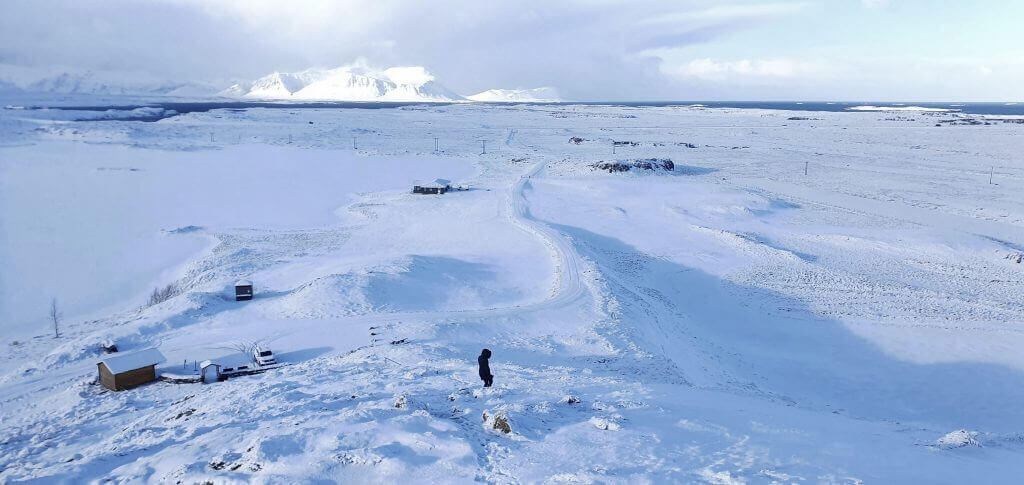
Helgafell hike in winter
Why Visit
Helgafell hike is a hidden gem on the Snæfellsnes peninsula. We have never heard any tourist mention this hike, yet it’s one of the most picturesque hikes in Snæfellsnes!
Helgafell is a little hill south of Stykkishólmur, next to the Helgafellsvatn lake. It’s well accessible all year round, even when it snows.
Tips from a Local
- There are many Helgafells in Iceland. Be sure to type the right one into your navigation 🙂
- The hike is short and easy. In winter, it might be slippery due to snow and ice. Shoe spikes might help.
Our Experience
We’ve discovered Helgafell just by coincidence. We had an accommodation located just next to the lake and the accommodation owner recommended us this hike.
We went in early March with full snow coverage everywhere around. We were lucky to have a clear sky and a sunny day, so we could fully enjoy some amazing 360° views from the peak of Helgafell!
The hike took us less than 10 minutes one way and is totally worth a short in our opinion!
H5. Klukkufoss Waterfall

Klukkufoss waterfall. Photo by Bromr, CCM license. Source link.
Why Visit
Klukkufoss is a very little visited waterfall away from any crowds located next to the F-road F575. At the same time, Klukkufoss is one of the cutest and prettiest waterfalls in Snæfellsnes!
Tips from a Local
- It takes just a short hike to reach the waterfall. At the bottom of the hike, there is a picnic area with a table and benches and two parking spaces.
- Other interesting things to see nearby are Eyvindarhola Lava Cave (not our cup of tea), Rauðhóll hill, or another hidden waterfall called Snekkjufoss.
Our Experience
What we love about Klukkufoss are the picturesque basalt columns, the remoteness of the waterfall, the stunningly tranquil surroundings, and the easy access.
H6. F575 F-Road

Road 575 in Snaefellsnes
Why Visit
F575 is one of the easiest F-roads in Iceland, yet it is beautiful and very little driven! The road leads just below the tallest peak of Snæfellsnes – Snæfellsjökull.
Eysteinsdalsleið, or F575, is a steep gravel mountain road connecting the western shore of Snæfellsnes with another mountain road below Snæfellsjökull – (F)570.
Tips from a Local
- F575 is one of the very few F-roads in Iceland with no river crossings. Once the snow melts, you could drive the road in any 4WD car.
- Eysteinsdalsleið is passable only in summer and may open a bit later than other F-roads. Always check www.trafficinfo.is before driving!
Do you love waterfalls? We wrote the List of (almost) ALL Icelandic Waterfalls.
Our Experience
We drove the road for the first time in mid-July, soon after it opened to summer traffic. There were still remains of snow around the road (but not on it) after a strong winter.
While steep, F575 was easy to drive, and we can recommend it as a nice introduction to Icelandic F-roads. You can drive it in connection with 570 to enjoy these two most beautiful mountain roads in Snæfellsnes.
H7. Rauðhólar Hill

Rauðhólar hill, an amazing picture by Jón Bjarni Jónsson
Why Visit
Rauðhólar is a colorful, hilly area in eastern Snæfellsnes that almost nobody knows about! Not even locals. Rauðhólar is a wonderful place for photographers, especially on a nice day.
Tips from a Local
- There is also “Rauðhólar” next to Reykjavik, which is a totally different place. Don’t get it confused.
- Don’t miss the wild Sturlungalaug hot spring just around the corner, too!
Our Experience
Rauðhólar is a beautiful spot that was recommended to us by our kind friend Jón Bjarni Jónsson, for which we are very thankful!
You can get to Rauðhólar hill by turning to Road 55 from Road 54 in the south, near Kolbeinsstaðakirkja church, and then taking the first turn left to the gravel road. The road may not be passable when there’s too much snow, so take care!

Wind playing with horses’ hair near Helgafell in Snæfellsnes. One of our favorite shots.
When to Visit Snæfellsnes
You can visit Snæfellsnes all year round! Most of the roads are well paved and most of the attractions are accessible also in winter. Just dress well, rent a proper car for Iceland, and avoid weather alerts.
We actually recommend you go see Snæfellsnes at least once in the summer and once in the winter. It’s an entirely different sight.
How to Get to Snæfellsnes
Getting to Snæfellsnes is easy and convenient. It’s just a 2-hour drive from Reykjavik on well-maintained roads.
You can also get to Snæfellsnes by a combination of buses from Reykjavik, though we don’t recommend that. It’s a long journey, and you’ll need a car or tour anyway to fully explore the peninsula.
Best Snæfellsnes Guided Tours
If you don’t have a car, we recommend taking a guided tour. A good tour will show you all the highlights of Snæfellsnes in one day, and you’ll have beautiful memories with very little effort.
Our favorite Snæfellsnes full-day guided tours are:
- Wonderful Snæfellsnes Full Day Tour from Reykjavik by NiceTravel, 5% discount code: EPICICELAND
- Small Group, full-day Snæfellsnes Tour from Reykjavik, 5% discount code: EPICICELAND24
- Vatnshellir Cave Tour near Arnarstapi in the south Snæfellsnes
And our personal favorite guided activities in Snæfellsnes are:
- Orcas Whale-Watching tour from Hólmavík
- Snæfellsjökull glacier hike tour – hike to the tallest peak of Snæfellsnes – only for the brave!
- Amazing Kirkjufell Kayaking tour – great for everyone!
- Stykkishólmur Sea Kayak tour – our favorite tour from Stykkishólmur

Want a private Snæfellsnes tour? We can take you there! We run niche, fully tailored private tours all around Iceland and can fulfill any wish you have!
How Long to Stay in Snæfellsnes
We recommend staying in Snæfellsnes for one or two days. In winter, it’s better to plan for at least two days due to the unpredictability of the weather.
If you are short on time, you can see the main highlights of the peninsula in one day. In two days, you can take a more leisurely pace and explore even more.
That being said, Snæfellsnes has enough to offer even for a week. If you prefer slow travel, you won’t make a mistake even with more days of up to a week!
Snæfellsnes 1-Day Itinerary

Lóndrangar cliffs in winter
You can see the main sights of Snæfellsnes in one day. It will be a bit of a rushed day, but it’s perfectly possible. No time will be left for any hidden gems, though. Here’s our sample 1-day Snæfellsnes itinerary:
- 9:00 – 9:30 Selvallavatn and Selvallafoss
- 10:00 – 10:30 Kirkjufell and Kirkjufellsfoss
- 11:30 – 12:00 Lóndrangar Cliffs
- 12:15 – 13:45 Arnarstapi village with lunch
- 14:00 – 15:30 Stóri Kambur beach horse riding (Optional)
- If you don’t feel like riding the horses, you can just take a walk to the beach from the same place. It will take you more or less the same time. If it’s too long for you, there’s a farm road that can take you closer to Hraunlandarif beach.
- 16:00 – 16:15 Búðakirkja church
- 16:45 – 17:30 Ytri Tunga seal watching
- 17:45 – 19:30 Lýsulaugar hot springs (with facilities) or wild Landbrotalaug hot spring (without facilities)
The last time we visited Snæfellsnes was in early March. You can read more about our 2-day winter Snæfellsnes trip here.
Snæfellsnes 2-Day Itinerary
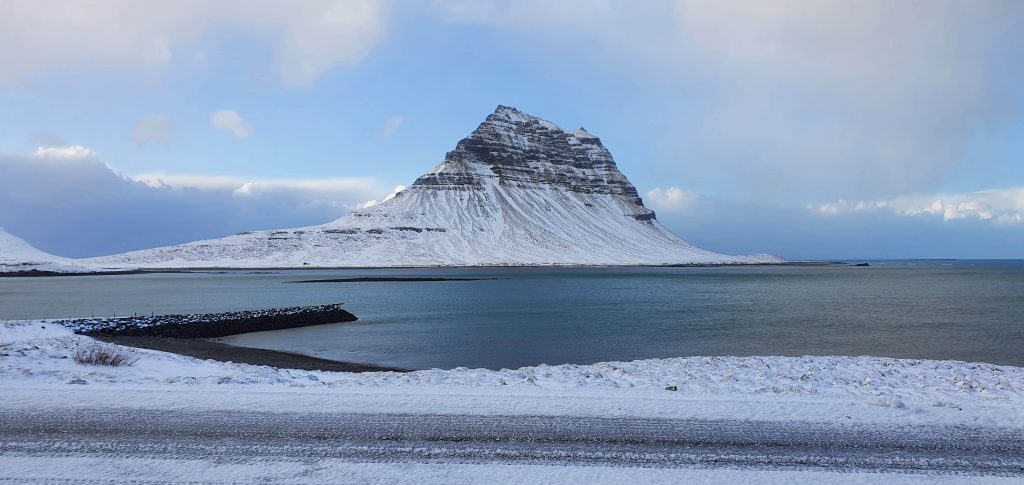
Kirkjufell, as seen from Grundarfjörður in winter
In two days, you can take a more leisurely pace and see most of the beautiful places in Snæfellsnes. I’ll assume a summer visit (May to October) because we have a separate article for a 2-day winter Snæfellsnes itinerary. Without further ado, here’s our sample summer 2-day Snæfellsnes itinerary:
Day 1
- 9:00 – 10:30 Sturlungalaug hot spring
- 11:15 – 11:45 Selvallavatn and Selvallafoss
- 12:00 – 12:30 Helgafell hike
- 12:45 – 13:00 Berserkjahraun road
- 13:15 – 13:30 Kolgrafarfjörður view point
- 13:45 – 15:00 Grundarfjörður lunch
- 15:15 – 15:45 Kirkjufell and Kirkjufellsfoss
- 16:00 – 18:00 Kirkjufell kayaking tour
- 18:15 – 19:00 Grundarfoss hike
- Night in Grundarfjörður or Ólafsvík

Stapafell mountain in March
Day 2
- 9:00 – 9:45 Skarðsvík Beach and Svörtuloft Lighthouse
- 10:00 – 10:30 Saxhóll crater
- 10:30 – 11:30 Drive the scenic F575 Road and (F)570 Road down to Arnarstapi, stop for views (Optional)
- If you don’t feel like driving the scenic mountain roads, you can just drive up to the Klukkufoss waterfall, take the short hike, and drive back south around Djúpalónssandur towards Lóndrangar.
- 11:45 – 12:00 Lóndrangar Cliffs
- 12:15 – 14:00 Arnarstapi village with lunch
- 14:15 – 16:00 Stóri Kambur beach horse riding (Optional, same as for our 1-day itinerary above)
- 16:15 – 16:30 Búðakirkja church
- 17:00 – 17:45 Ytri Tunga seal watching
- 18:00 – 19:30 Lýsulaugar hot springs (with facilities) or wild Landbrotalaug hot spring (without facilities)














